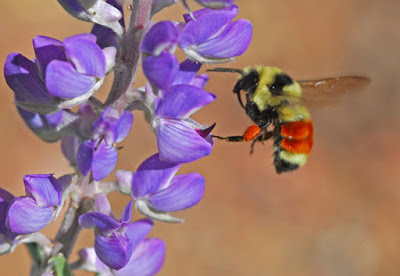 |
| Bombus huntii photo bugGuide.net |
There have been many articles written about the plight of the honeybees and the decline in their numbers. This is definitely a concern for all of us who love to see these bees active in our garden and pollinating the plants.
I read a recent article that stated now Bumblebees may be on the decline. Learning more about any pollinator will help us all have a more inviting and supportive environment for them to grow and thrive may help reverse this trend.
Bumblebees are very active pollinators and move fast through any plant where they are foraging. It was difficult to snap a picture quickly enough to capture them in action because these bees can move fast in their effort to get the nectar and pollen before another competitor comes along. Like honeybees, they are social bees. Bumblebees have annual nests and they do make wax but they don’t produce honey and their value as a pollinator is still very important.
You can hear a bumblebee active at work because they actually do make a noticeable buzz sound. They feed on nectar and gather pollen like other bees, but they are “buzz pollinators” and use their strong jaws to vibrate plants that other bees and pollinators may not be able to manage. They are larger and fuzzier than honeybees and stand out with their yellow and black stripes and some have colorful markings. Colorado is home to a number of native bumblebees.
The attached articles give some great tips on which plants that certain pollinators like Bumblebees will be attracted to and ones that are not. By adding just a few more of these plants each year to your landscape, you can make a significant difference in the number of pollinators that visit your garden.
http://www.ext.colostate.edu/pubs/insect/05525.html
http://www.ext.colostate.edu/sam/garden-insects.pdf
http://www.ext.colostate.edu/sam/bees-wasps.pdf
http://www.colostate.edu/Dept/CoopExt/4dmg/PHC/bumble.htm
http://www.ext.colostate.edu/sam/garden-insects.pdf
http://www.ext.colostate.edu/sam/bees-wasps.pdf
http://www.colostate.edu/Dept/CoopExt/4dmg/PHC/bumble.htm



